The Garmin Fenix 7 Sapphire Solar is the brand’s flagship solar-enhanced GPS multisport smartwatch, succeeding the Garmin Fenix 6 with improved battery life, new training features and a new touchsreen.
The Fenix 7 boasts a battery life that will last weeks thanks to its solar harvesting capability.
It comes loaded with maps and has activity profiles for different sports.
The watch can support interval training, HIIT workouts and dedicated training plans. It uses data from the optical heart rate monitor to provide insight into your performance and recovery over time. There are ‘wellness’ functions such as a perceived ‘Body Battery’ score and stress levels.
Many day-to-day features will be familiar to users of Garmin smartwatches, and the best smartwatches more generally. These include push notifications from your smartphone, contactless payments and the ability to store music on the watch.
You can customise the watch by downloading apps via the Garmin Connect IQ app and changing the appearance of the watch face.
This functionality does come at a price, with the Fenix 7 Sapphire Solar costing £779.99 / $899.99 / €899.99.
So does this breadth of functionality justify the price tag? And would you be better off with a dedicated bike computer for cycling?
Garmin Fenix 7 Sapphire Solar GPS smartwatch details and specifications
Size, design and connectivity
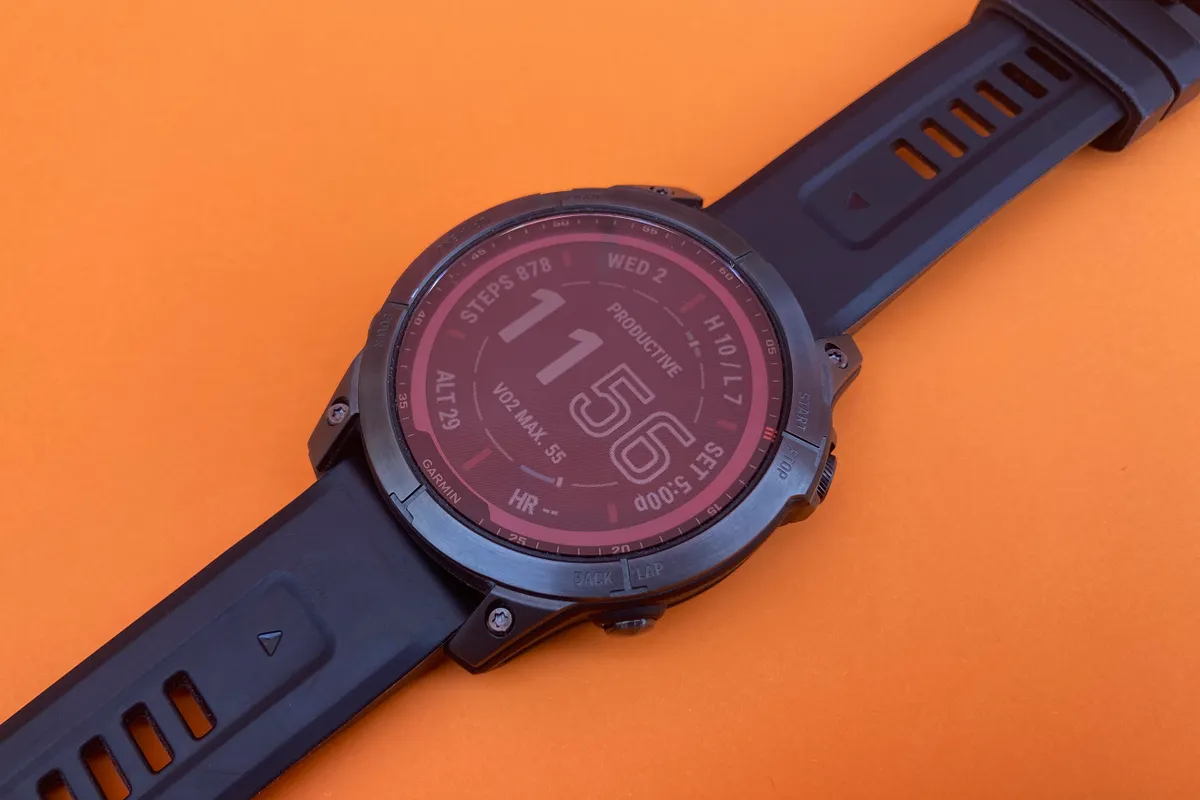
This Fenix 7 I tested has a 47mm carbon grey titanium case with a 1.3in display. It is 14.5mm deep and weighs 73g with the standard silicone strap, and is designed to fit wrists down to 108mm in circumference.
The Fenix 7 has a 260×260 pixel resolution transflective colour LED display, which means it's clear and easy to read in direct sunlight. The display has a backlight for use in low light.
This is the first time you have been able to buy Garmin’s Fenix watch with solar harvesting and the Sapphire reinforced screen.
You can connect devices such as heart-rate monitors and power meters to the watch via Bluetooth and ANT+ and you can connect it to WiFi networks for easy uploads to Garmin Connect or apps such as Strava.
The watch is water-resistant to 100m.
Solar charging and battery life
This Fenix 7 comes with Garmin’s solar charging, which helps boost the battery life of the watch to up to 73 hours in GPS mode or 22 days in smartwatch mode. The battery saver mode increases that figure to 173 hours with solar.
This shows a marked increase in battery life over the Garmin Fenix 6 Pro Solar, which features up to 40 hours in GPS mode and 16 days in smartwatch mode.
The caveat here is these claimed figures require three hours of exposure to sunlight a day in 50,000 lux conditions. Pinning down exactly what these conditions constitute in terms of weather and light is tricky, but if you’re wearing the watch under a sleeve, you’ll see a drop in these claimed stats.
Sports types

The Fenix 7 comes with more than 60 activity profiles loaded onto the watch, covering everything from cycling to climbing and gym work to parachuting. There are more activity types available to download from the Garmin Connect app, or you can create your own.
The cycling profiles include road cycling, mountain biking, cyclocross, gravel riding and electric bikes, to name just a few, and you can customise the data screens on each profile to suit your needs.
In-built sensors and fitness tracking
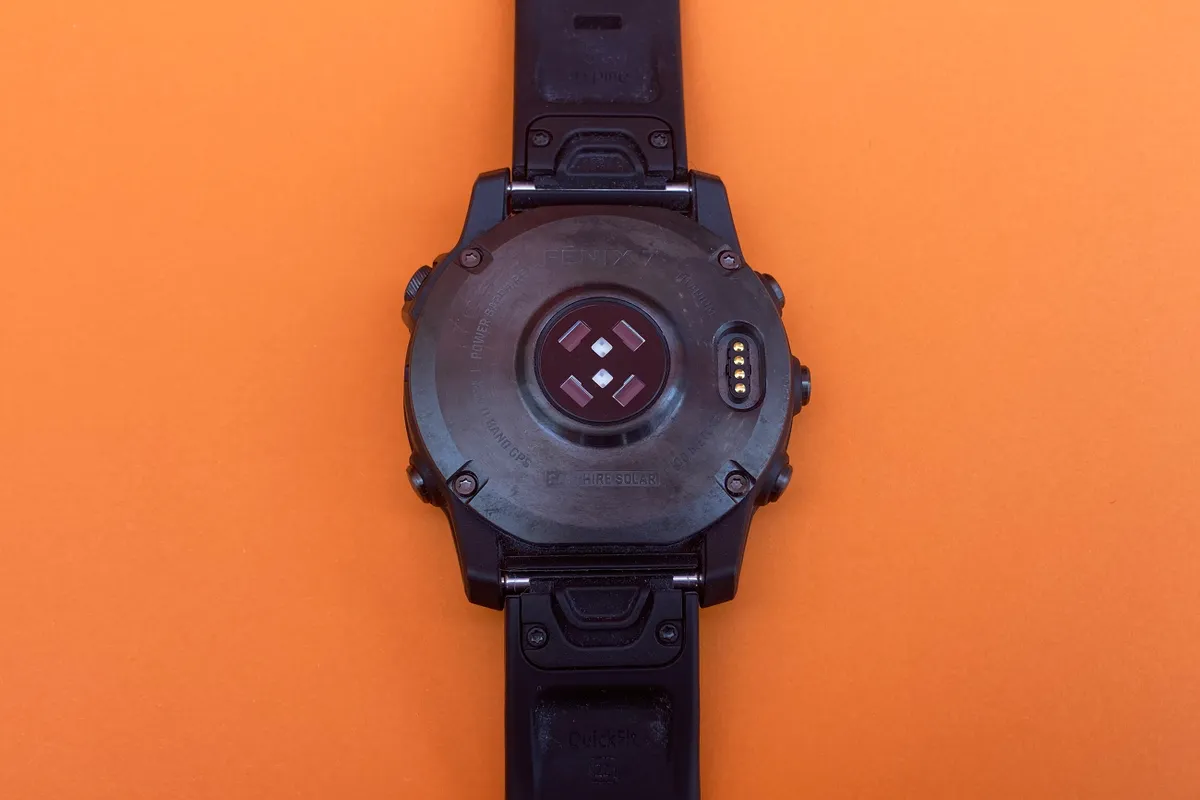
The Fenix 7 has an in-built heart rate monitor and Garmin’s ‘Pulse Ox’ sensor. This means the watch can provide training insights without the need for additional sensors.
The heart rate data forms the basis for the watch’s ‘wellness’ functions, providing snapshots of your sleep quality, perceived energy levels and stress. This data also informs the watch’s suggested recovery time (how long you rest after an activity), workout suggestions, training load and VO2 max estimates.
The watch can provide insight into respiration, alert users to abnormally high or low heart rates, and allow you to monitor your menstrual cycle.
The Pulse Ox feature that shows estimated blood oxygen levels can provide insight into how well your body is responding to acclimation.
Mapping and apps
The Fenix 7 comes loaded with topographical maps for a variety of activities including cycling, walking, running and golf.
Maps can be used without an internet connection or link to a smartphone. If the watch does not have maps already loaded for a certain location you can buy these from the Garmin website.
The mapping on the watch is powered by Multi-GNSS, a combination of GPS, GLONASS and Galileo.
The Sapphire Solar version of the Fenix 7 has multi-band frequency support, a feature that Garmin says was only previously available to the military and not on the Fenix 6.
This feature means the watch can access multiple frequencies sent by satellites, providing greater position accuracy in areas where signals don’t normally penetrate, such as in woods or among tall buildings.
The maps have a high level of detail, which is enhanced by the colour display. You can customise the appearance of the maps to optimise them for different purposes and light conditions.
The Fenix 7 will display points of interest on the map and the new function ‘Up Ahead’ can alert you to these features while out on an activity.
You can enhance the functionality of the Fenix 7 by downloading apps, such as Komoot, Trailforks and Spotify, via the Garmin Connect IQ store.
Garmin Connect app
Like Garmin’s bike computers, the Fenix 7 can be used in conjunction with the Garmin Connect app to unlock further insights into your activities and health statistics.
While you can use the Fenix 7 without the app, this is where you can set up functions such as Garmin Pay.
The app will collate data from the Fenix 7 and any other Garmin devices you use to give you an overview of all your activities and training.
Garmin Fenix 7 Sapphire Solar GPS smartwatch performance
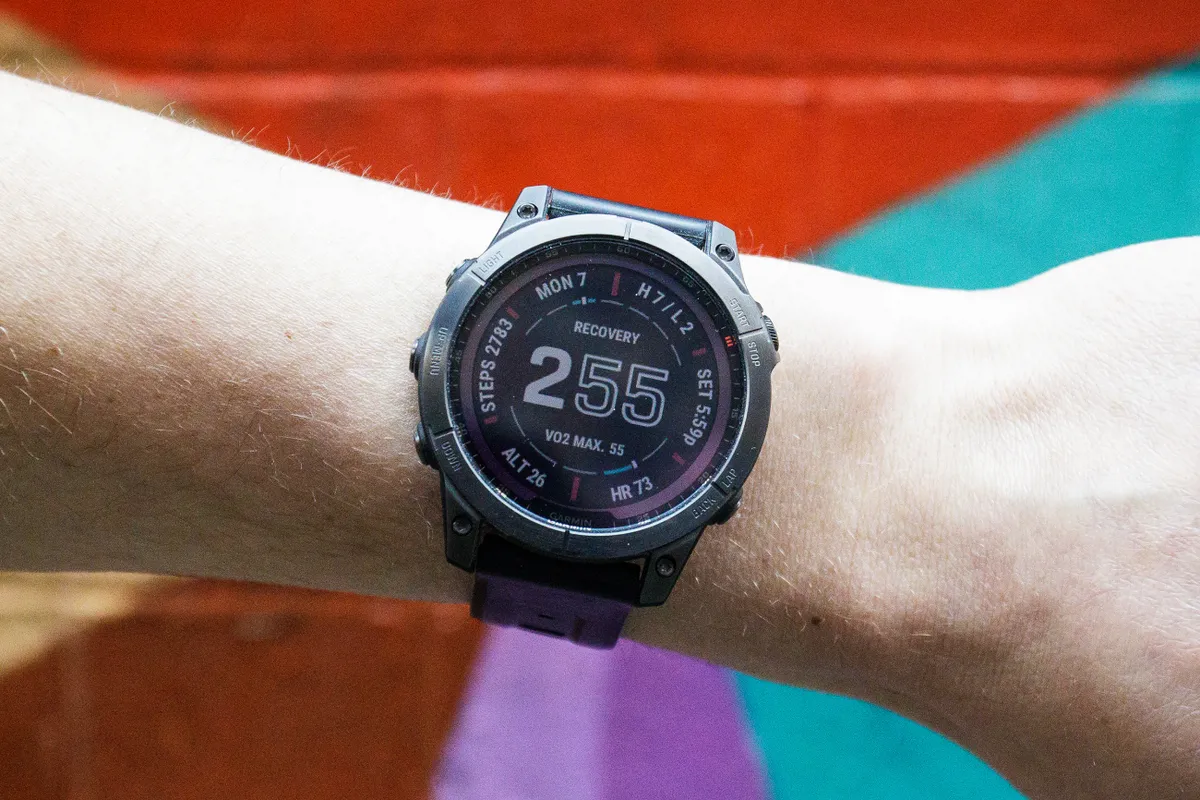
I tested the Fenix 7 over three months, using it for road cycling, gravel riding and running.
I’ve worn the Fenix 7 for activities, recording rides and using it to measure effort via the heart rate monitor, as well as for navigation. I’ve used the watch by itself for activities and alongside my Garmin Edge 1030 bike computer.
I also wore the Fenix 7 when not out cycling or running to get a sense of how its health functions work, as well as what it's like to use it day-to-day in conjunction with a smartphone.
While there are many different sports and activity profiles to choose from, my thoughts on the watch are largely in the context of testing it while road cycling.
Comfort and wearing
Despite the Fenix 7’s attention-grabbing size, it doesn’t feel too cumbersome to wear.
Like the Fenix 6, its low weight means it doesn’t weigh down your wrist, and is pretty much unnoticeable when wearing it for activities.
Although the Fenix 7 is shallower than the Fenix 6, I did find it tricky to fit under my slim cycling jacket or jersey sleeves.
Hiding the Fenix 7 away like this means you can’t see the watch face or benefit from the solar charging. But testing it through cold January weather meant there were times when stopping wind or water ingress was preferable to seeing what was displayed.
Ease of use
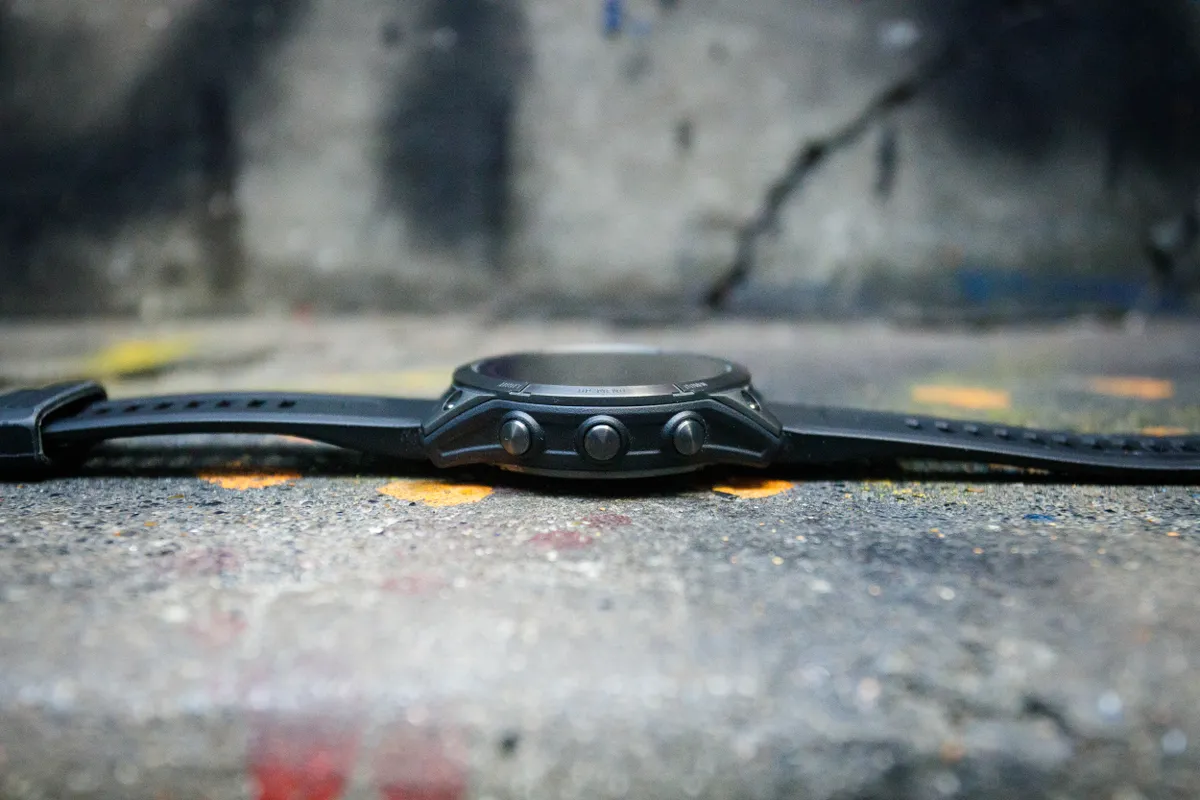
One of the major updates to the Fenix 7 is the introduction of a touchscreen, bringing it in line with more typical day-to-day smartwatches – a market Garmin definitely wants to enter.
The inclusion of a touchscreen makes the Fenix 7 feel intuitive to use straight out of the box.
It makes flicking through the watch’s many menus a straightforward activity compared to using the five buttons on the bezel. But the buttons on the bezel did prove easier to use than the touchscreen when wearing gloves.
As Alex Evans found when testing the Fenix 6, I didn’t have to use the screen’s backlight in daylight hours and the lowest brightness setting was enough to view the screen in low light.
I will say that while the colour screen helps highlight detail on the maps and enables you to see which heart rate zone you are in at a glance, I did find it slightly less clear than the monochrome display on the Garmin Instinct 2.
Battery life and solar charging
The Fenix 7’s battery life is genuinely impressive.
I only had to charge the watch every two to three weeks while using it to record roughly five hours of activities a week and record my heart rate, while leaving it constantly paired to my phone.
It’s difficult to assess exactly how use impacts the watch’s charge because different settings and types of use will demand different amounts of power.
But as a guide, I used the watch for a four-hour activity and the battery was depleted by 22 per cent from 100 per cent. For this activity, I didn’t use solar charging and wasn’t following a route, but the watch was paired with my phone.
I never noticed an increase in battery life from when the watch was exposed to daylight for long periods – for instance, being outside for five hours at a time on a trip to Tuscany. However, this did seem to minimise the rate at which the battery’s charge diminished.
Garmin claims 22 days battery life in GPS mode if you expose the watch to three hours of sunlight per day in 50,000 lux conditions.
Leaving the watch in the sun for three hours on a typical summer day, with a mix of bright sun and intermittent cloud cover, I saw only a one per cent drop in the battery. The watch reported that it had been exposed to 63,700 lux hours in this time.
So while you shouldn’t expect the watch to work solely off solar charging, it’s safe to assume that solar charging will extend the battery life significantly.
Heart rate, fitness and training
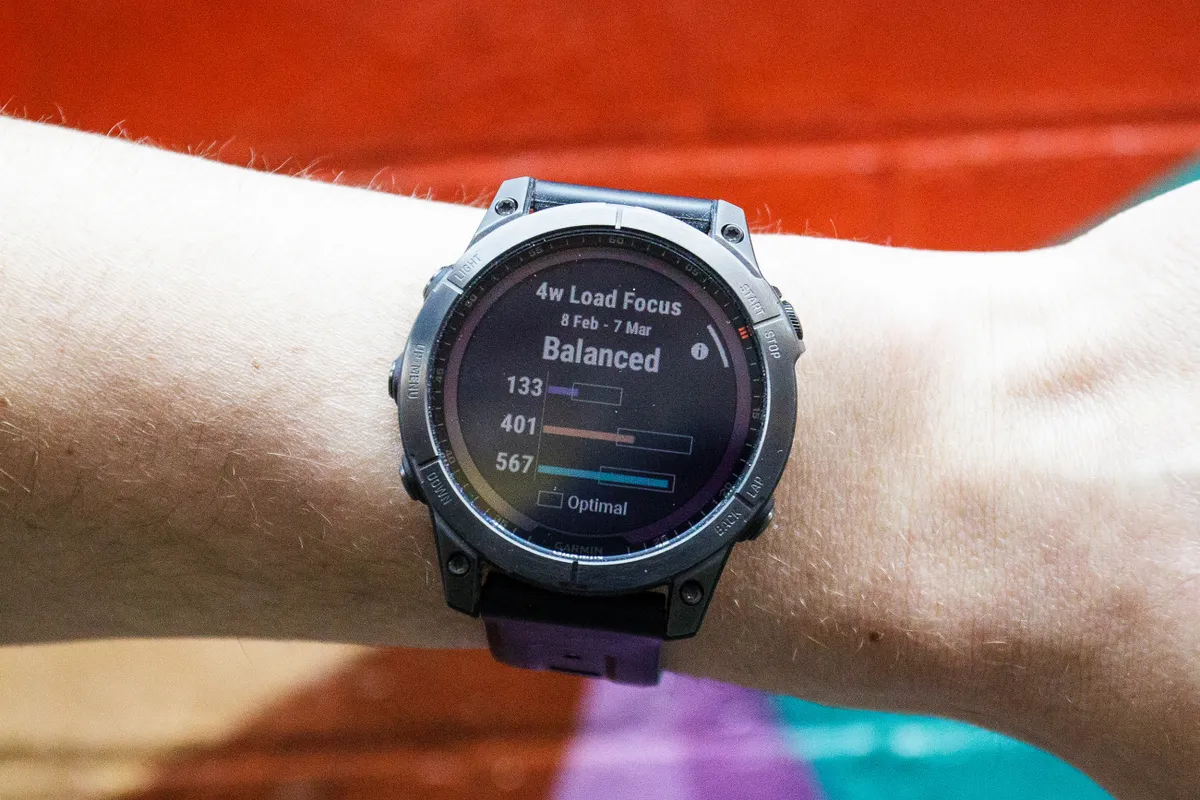
The Fenix 7 has a variety of algorithm-based fitness monitoring functions including training load, training status, recovery time, Body Battery and sleep monitoring.
In principle, these functions can provide a great deal of insight into how your fitness and performance is developing over time, as well as helping you determine what your body needs in terms of rest.
However, these functions are only as good as the data the watch receives and this is where I ran into some issues with the Garmin Fenix 7.
I often found the Fenix 7’s optical heart rate monitor to show different readings to a chest-strap heart rate monitor linked to my Edge 1030.
When I started climbing hills and my effort increased, the Fenix 7 would often take longer to reach the heart rate displayed on my Edge 1030 – if it reached it at all – and it struggled to reflect smaller fluctuations in my heart rate as I was just pedalling along.
There are a number of reasons why wrist-based monitors can be less accurate than chest-strap monitors, including how tight the watch strap is, skin colour, vibrations and blood flow.
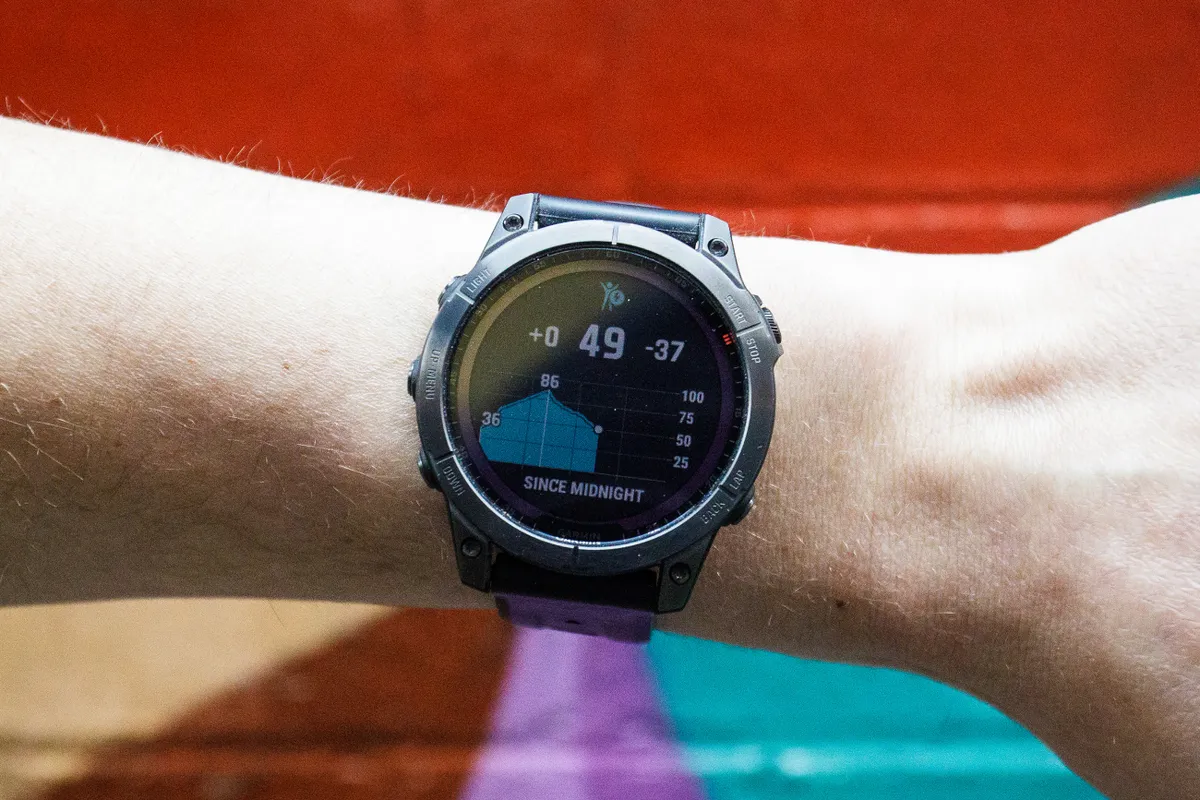
These aren’t problems unique to Garmin and a number of reviewers have noted issues with this style of heart rate monitor when testing smartwatches. But the knock-on effect of this is that I came to treat the fitness monitoring functions on the Fenix 7 with a level of scepticism.
I ended up pairing the watch with a chest-strap heart rate monitor for my rides, which defeated some of the utility of the watch when cycling. This did mean I could wear the watch over my jersey or jacket because it no longer had to have contact with my skin, which was welcome in the cold or rain.
For running, the Fenix 7 uses heart rate data to provide you with a Training Status and an estimated VO2 max. It uses this data for Garmin’s new Stamina function, which allows you to monitor exertion during an activity.
To use these functions for cycling, you need to pair the Fenix 7 with a power meter. This is potentially another chunk of cash on top of the watch’s high price if you want to unlock its full potential. But you also need a power meter to use these functions on a Garmin bike computer. So, in this regard, the Fenix 7 is no more limited than the brand’s cycling-specific products.
Using the watch for running and cycling, but without a power meter, did present more ambiguity. The watch would display my training status based on running, but this was not a true reflection of what was happening for me across sports.
Sensor accuracy
I never found the Fenix 7 to struggle when locating satellites, eliminating the sometimes frustrating delay to the start of a ride.
When comparing my experience of the watch’s other sensors, there doesn't seem to have been any great improvement from Alex Evans’ experience of the Fenix 6.
Like the Fenix 6, the barometric altimeter on the Fenix 7 still fluctuates if the watch hasn’t had a GPS signal in a few days or you haven’t used its altitude-calibration feature. But this is a quickly rectified issue, and I never had any wildly inaccurate readings when out recording an activity.
The compass is still accurate, but because I didn’t use the watch for orienteering, it was a feature I rarely employed.
The temperature function suffers from the same issues Alex outlined, where body heat could influence its readings.
Mapping and navigation
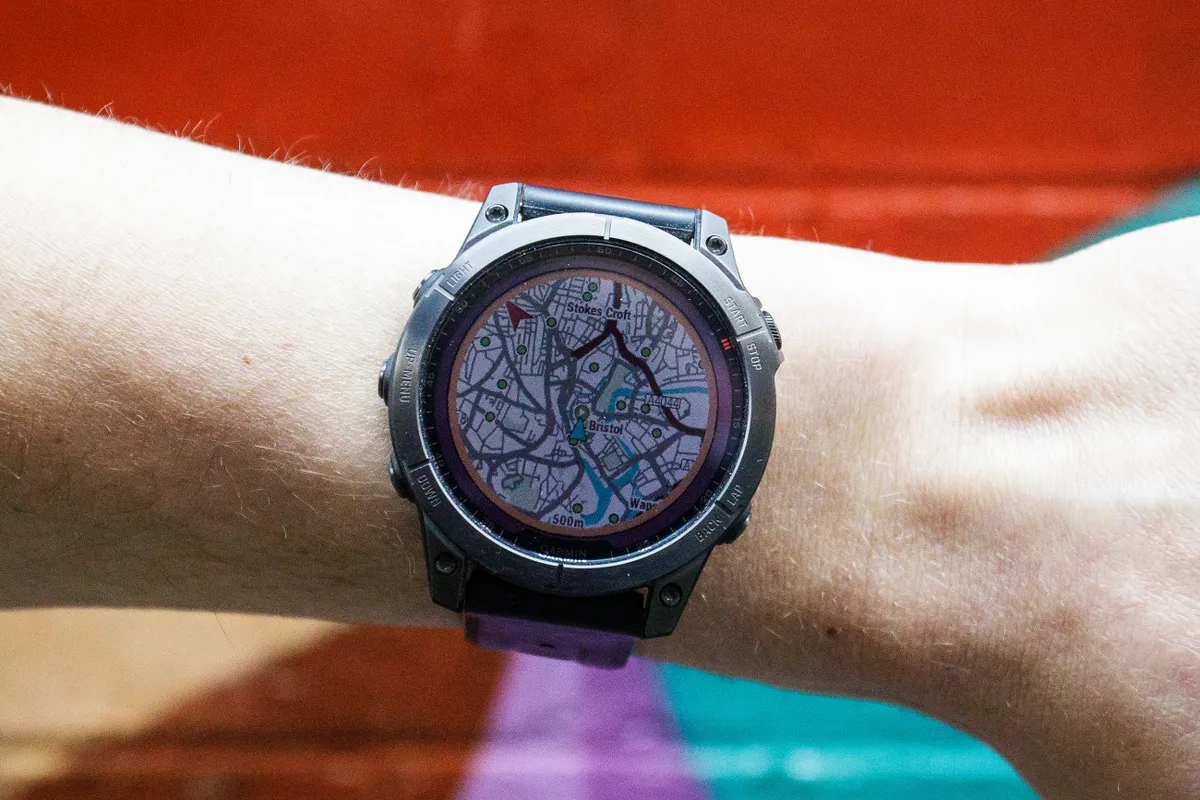
The Fenix 7’s mapping is easy to read with a good level of detail, showing roads, paths, points of interest and natural features.
The closer you zoom in on the map, the more detail there is, and you get a true sense of the map’s details when the scale is at 800m or below.
Garmin says there are only contour lines available on certain regions of the watch’s UK map, but the map would be more instructive and usable if there were contour lines across the map in all territories.
The new touchscreen on the Fenix 7 makes using the maps easier than on the previous Fenix because you can scroll across the map with your forefinger rather than having to rely on using the buttons on the bezel.
This brings the Fenix 7 more in line with the functionality of Garmin’s Edge bike computers, but there’s no getting away from the fact the small screen makes using the map more fiddly than on a larger bike computer.
The screen size doesn’t hinder following routes a great deal, though, with the screen’s clarity and the turn-by-turn helping you discern which way to go.
I downloaded the Komoot app from the Garmin Connect IQ and this proved an easy way to select routes to follow, although I did have to make sure the watch was linked to my phone to download them.
You can change the appearance of the map to high-contrast or dark, which helps clarity in certain light conditions.
The only real drawback for me was using the watch for navigation on a road bike meant that unless I had my hand resting on the top of the handlebar the map was simply not visible to me.
This might seem like a small issue, but it was only once I started using the Fenix 7 that I realised how frequently I check my bike computer when using it to navigate.
Smartphone integration
The Garmin Fenix 7 will integrate with your smartphone and act as an auxiliary device in the same way as other less sport-orientated wearables, such as the Apple Watch.
This is less to do with its practicality as a tool for cycling, but I’m sure these features are what make the watch an appealing choice for many, as well as being one of the biggest differences between the watch and a bike computer.
Being able to pause music or skip tracks was a feature I appreciated when using the watch day-to-day. I also enjoyed being able to access my phone’s calendar, receive message notifications and see when someone was calling while I was away from my phone.
Garmin Pay, which enables you to make contactless payments with the watch, was a feature I was looking forward to trying out. But unfortunately, in the UK at least, few banks are supported, and mine was not one of them.
Garmin Fenix 7 Sapphire Solar GPS smartwatch bottom line

The Garmin Fenix 7 Sapphire Solar is a do-it-all adventure watch that has more functions than any single person could – or would – make use of. It has a number of upgrades from the Fenix 6, including the touchscreen, solar charging with a reinforced screen for the first time, and improved positioning.
It can compete with the best bike computers, and the only places it is really let down for cycling are where smartwatches more generally fail. The comparatively small screen makes navigation harder than on a bike computer and the fact it’s worn on your wrist means it’s not as visible as a computer mounted to your handlebar.
While a smartwatch is arguably advantageous for mountain biking and cyclocross, as a road cyclist, the Fenix 7 will never replace my bike computer fully. However, there’s no denying the convenience of this watch. The mighty battery life means you rarely have to worry about the charge and while the heart rate monitor isn’t as accurate as a chest-strap monitor, at least it has one built in.
A number of training features might be off-limits without a power meter, but this is no different to Garmin’s bike computers.
As a device solely for cycling, the Garmin Fenix 7 strikes me as excessive. But ultimately, that’s not what this watch is about. If you have the money and like the idea of a device that can support you through practically any activity or adventure, and makes a statement in the process, then the Fenix 7 Sapphire Solar will likely be an appealing choice.
Product
| Brand | Garmin |
| Price | €899.99, £779.99, $899.99 |
| br_whatWeTested | Garmin Fenix 7 Sapphire Solar, 47mm, silicone band, carbon grey titanium |
| Weight | 73g |
Features
| Rechargeable battery | yes |
| Turn by turn navigation | yes |
| Screen type | Fenix_6_Pro_Solar_Screen |
| Screen type | touchscreen |
| Connectivity | antPlus |
| Connectivity | bluetooth |
| Connectivity | wifi |
| Maps | Topographic, Garmin cycle map, road and trail, golf, ski resort |
| Dimensions | 47mm diameter, 14.5mm deep |
| Battery life | Up to 22 days in smartwatch mode, up to 73 hours in GPS mode |
| Water resistance | 10ATM |
| Screen dimensions | 1.3in |
| Display resolution | 260x260 |
| Sensor compatibility | Speed and cadence, power meter, heart rate |
| Heart rate monitor type | Wrist-based |
| Replaceable strap | 1 |
